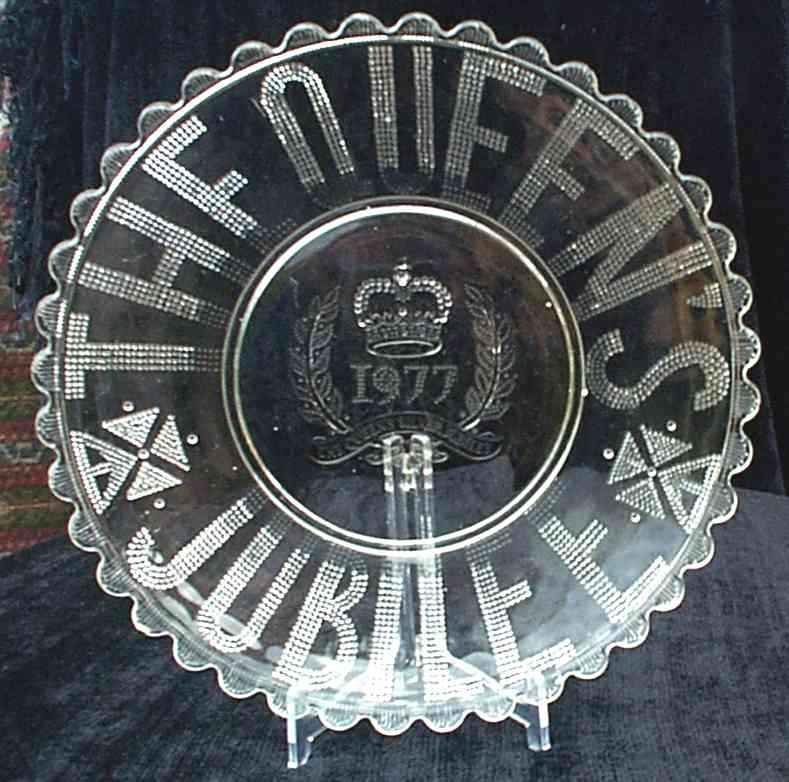|
|
|||||||||||||||||||||||
|
|||||||||||||||||||||||
The initial post-war period was very difficult for all glass manufacturers. Shortages of raw materials and manpower limited the amount of glassware that could be physically produced. Government regulation in the home market and import restrictions imposed by other countries limited what could actually be sold. To make matters much worse this business environment was constantly changing. Major importers of Davidson glass, such as Australia and New Zealand, introduced and removed import restrictions as their circumstances changed. Restrictions in the supply of glassware to the home market also changed several times and was not finally removed completely until 1953. High rates of purchase tax also acted as a barrier to the buying public.
 Despite this Davidson were
confident about their future. As they moved over from war time production, they
began to re-introduce pre-war lines such as the 'Ripple' pattern and the
Chippendale range of glassware. Coloured glassware was limited to amber and
emerald, with a small amount of Amber Cloud glass. The immediate post-war period
was not one conducive to introducing new lines. Indeed in 1947 they told there
first dedicated designer, W J G Fullerton,
that he should seek employment elsewhere as there was no work for him at
Davidson. The Ripple pattern was probably Fullerton's most lasting legacy.
Despite this Davidson were
confident about their future. As they moved over from war time production, they
began to re-introduce pre-war lines such as the 'Ripple' pattern and the
Chippendale range of glassware. Coloured glassware was limited to amber and
emerald, with a small amount of Amber Cloud glass. The immediate post-war period
was not one conducive to introducing new lines. Indeed in 1947 they told there
first dedicated designer, W J G Fullerton,
that he should seek employment elsewhere as there was no work for him at
Davidson. The Ripple pattern was probably Fullerton's most lasting legacy.
In reintroducing pre-war designs Davidson was careful in selecting only the ranges which were their best sellers. For example, the very large range of pre-war flower bowls was reduced to the number 21, 34SD, S696D, 1910SD and 1907TD flower sets, all of these were made in Amber Cloud. The 204 range of posy sets was reduced to just two sizes 7.5 and 9 inches diameter. It seems that large flower and posy sets were not what the public wanted or could afford to buy.
A number of pre-war designs for fruit sets and like items were also reintroduced. These included the 937 fruit set, Registered Design No 825955 and the 940 fruit set, Registered Design No 831491. Fruit sets came in either 14 or 7 pieces. The seven piece sets consisted of a large serving bowl and six small bowls. The 14 piece set consisted of the same bowls, but each bowl having an under plate.
The first new post-war design was the the No 500 fruit set which was introduced in 1949. This was a 14 piece set consisting 6 round fruit bowls and under plates and large serving bowl and under plate. Initially available in flint, emerald and green it was aimed at the export market. The 500 design, like so much of Davidson's designs from the Victorian era, imitated cut glass.
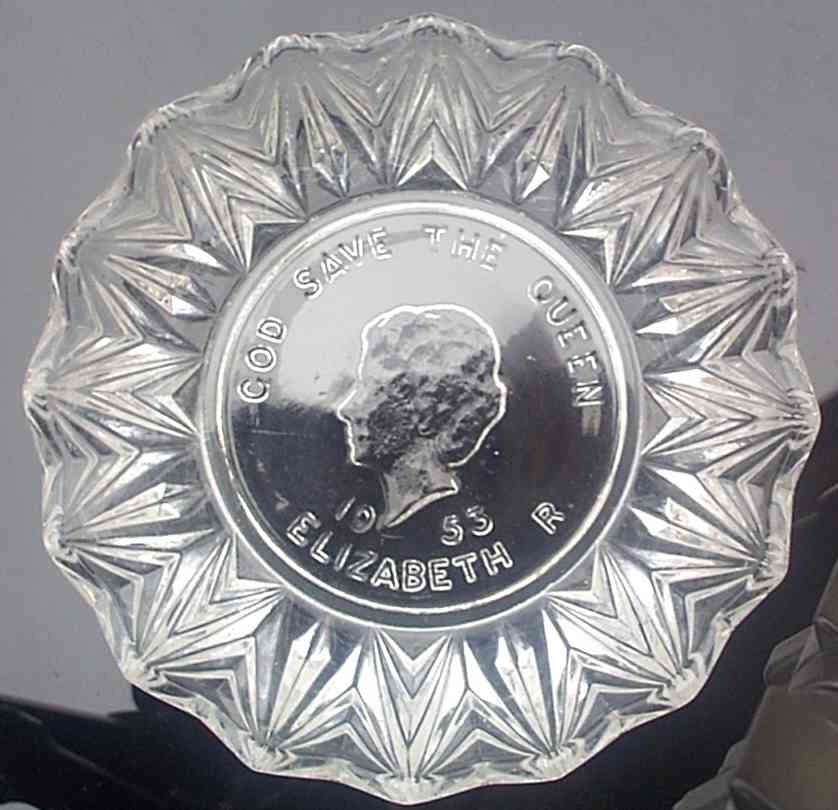 The (final) revocation of the
'Control of Manufacture and Supply
Order' in July 1953 was obviously a big boost for Davidson. In the following
year they introduced two new designs and a brand new colour. Lovat blue, which was
the blue-green colour of the Fraser tartan, was shown to the public for the
first time at the 1954 British Industries Fair (BIF). Davidson initially made only eight
designs in this colour, all of which were flower and posy sets. These were - 24,
24M, S696D, 732F, 1907TD, 1910SD, 204D and 204C. The last two were only
made in the 7.5" size.
The (final) revocation of the
'Control of Manufacture and Supply
Order' in July 1953 was obviously a big boost for Davidson. In the following
year they introduced two new designs and a brand new colour. Lovat blue, which was
the blue-green colour of the Fraser tartan, was shown to the public for the
first time at the 1954 British Industries Fair (BIF). Davidson initially made only eight
designs in this colour, all of which were flower and posy sets. These were - 24,
24M, S696D, 732F, 1907TD, 1910SD, 204D and 204C. The last two were only
made in the 7.5" size.
The two new styles, also shown at the British Industries Fair, were another fruit set, the 501, and the No 1 Wall Vase. The fruit set was available in Flint, amber and emerald and the wall vase in amber and emerald. The wall vase was a very deco design, which was unusual for Davidson who produced very few true deco designs. It was also the last gasp of the deco era. The 1950s were a decade of change, the austerity of the war years was past and people wanted something new.
 Although
not mentioned in the report of the British Industries Fair for 1954, Davidson
started to produce some of their range in black polished glass with fired-on
transfers, the transfers normally being of floral design. Designs in this
new finish included the No. 5 candy box, 644 celery, 24 and
24 M flower sets, 34SD flower set, 732F flower set and 204D and 204C posy sets.
The range was to increase in later years.
Although
not mentioned in the report of the British Industries Fair for 1954, Davidson
started to produce some of their range in black polished glass with fired-on
transfers, the transfers normally being of floral design. Designs in this
new finish included the No. 5 candy box, 644 celery, 24 and
24 M flower sets, 34SD flower set, 732F flower set and 204D and 204C posy sets.
The range was to increase in later years.
Amber Cloud Glass was still being made in 1954, although the range was much smaller than pre-war and was limited to the following flower sets and vases:
|
21 |
34SD |
283 8" |
|
S696D |
732F |
1907TD |
|
1910BD |
1910SD |
10/1910 |
|
204D 7.5" |
204D 9" |
No 51 Vase |
|
Good Companion Lamp |
10" Globe Lamp |
|
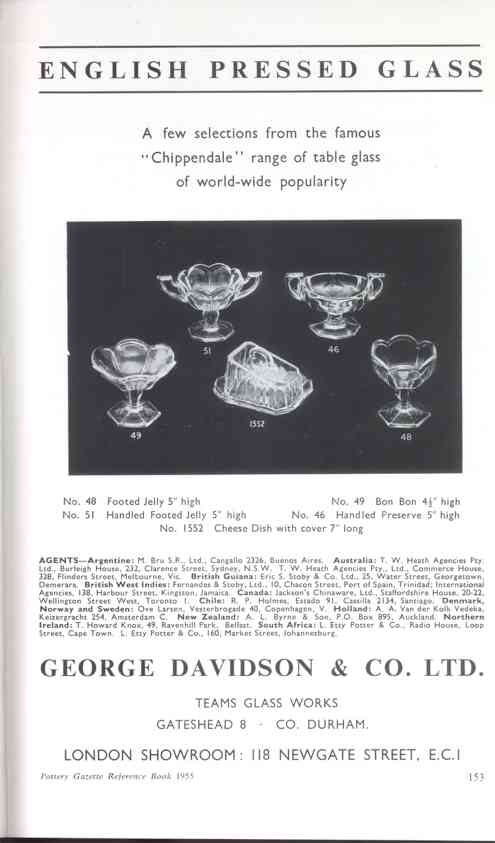 As
well as flint, emerald, amber, amber cloud and Lovat, some designs were also
available in smoke. Smoke was limited to the fan vase, ripple vases and
bowls and the 313 bowl. The Chippendale range was also still in production
in 1954, although the range was now limited to only 53 styles and only
available in flint. Davidson still considered Chippendale as one their major
lines. They renewed the trademark in 1951 and it featured in their advert in
the 1955 Pottery Gazette Reference Book and Directory. As
well as flint, emerald, amber, amber cloud and Lovat, some designs were also
available in smoke. Smoke was limited to the fan vase, ripple vases and
bowls and the 313 bowl. The Chippendale range was also still in production
in 1954, although the range was now limited to only 53 styles and only
available in flint. Davidson still considered Chippendale as one their major
lines. They renewed the trademark in 1951 and it featured in their advert in
the 1955 Pottery Gazette Reference Book and Directory.1955 saw Davidson's first visit to the Harrogate Fancy Goods Fair. This fair, which moved to Blackpool in 1956, started in 1949 and took over from the British Industries Fair as the main shop window for British glass and pottery. One of the main reasons for this was cost. A stand at the BIF was 10 times the cost of a stand at Harrogate. In fact the last BIF was in 1957.
|
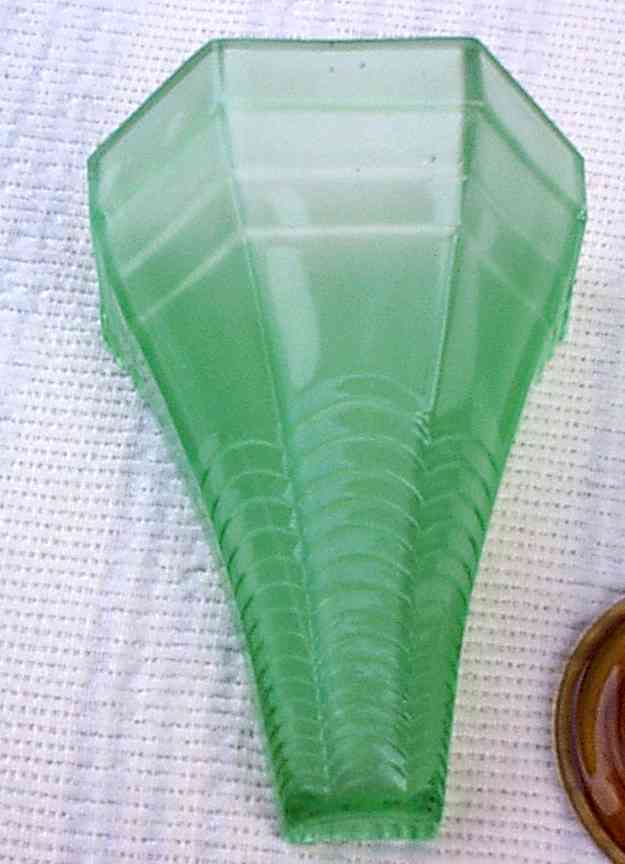 Davidson did not show any new designs in 1955, but displayed the
Lovat range and the black glass with transfer decorations. Adverts in
the Pottery Gazette for 1955 included the No 1 Wall Pocket, the 937 14 piece
fruit set and the 5283 trinket set. The fruit set and wall pocket were only
available in two colours, amber and emerald (the fruit set was also available in
flint). The trinket set was available in the larger colour range of flint,
amber, emerald, pink and blue. Two finishes were available, clear and matt
polished. Before the war trinket sets were large, the 283 for example had 8
pieces. Now the set was reduced to just 5 - a No. 4 tray, two small
candlesticks, a 4" powder jar and a single pin tray.
Davidson did not show any new designs in 1955, but displayed the
Lovat range and the black glass with transfer decorations. Adverts in
the Pottery Gazette for 1955 included the No 1 Wall Pocket, the 937 14 piece
fruit set and the 5283 trinket set. The fruit set and wall pocket were only
available in two colours, amber and emerald (the fruit set was also available in
flint). The trinket set was available in the larger colour range of flint,
amber, emerald, pink and blue. Two finishes were available, clear and matt
polished. Before the war trinket sets were large, the 283 for example had 8
pieces. Now the set was reduced to just 5 - a No. 4 tray, two small
candlesticks, a 4" powder jar and a single pin tray.
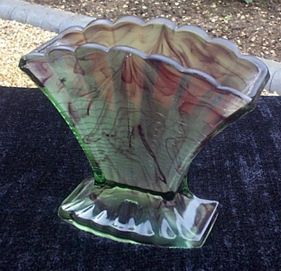 The following year again did not see any new designs. Davidson
again relying on the Lovat colour and the black decorated ware. Adverts in the
Pottery gazette showed the 503 and 504 Obscured fruit sets and the pre-war No
350 trinket tray. For "obscured" read "matt
The following year again did not see any new designs. Davidson
again relying on the Lovat colour and the black decorated ware. Adverts in the
Pottery gazette showed the 503 and 504 Obscured fruit sets and the pre-war No
350 trinket tray. For "obscured" read "matt ".
The 503 fruit set was based on the 1898 pattern, Registered Design No 320124.
".
The 503 fruit set was based on the 1898 pattern, Registered Design No 320124.
The first new Cloud Glass colour for 23 years was launched in 1957. Briar, which has a green base glass with purple trails, was shown at the Blackpool Fair. Briar, which is also known as Topaz by collectors, was used in flower sets, the Ripple range of vases and in the 'fan' vase. Several new styles were also shown for the first time. These included a new 500/4 7 piece fruit set which was square in shape rather than round, a 505 Harlequin fruit set with black under-plates and a No 507 posy. Davidson showed some ingenuity here, as the base of the posy is in fact the ashtray used in the 'Pullmatch' ashtrays made before the war (see the amber version on our ashtray and related items page) and the flint flower holder is decorated in the 1889 pattern Reg. No 320124.
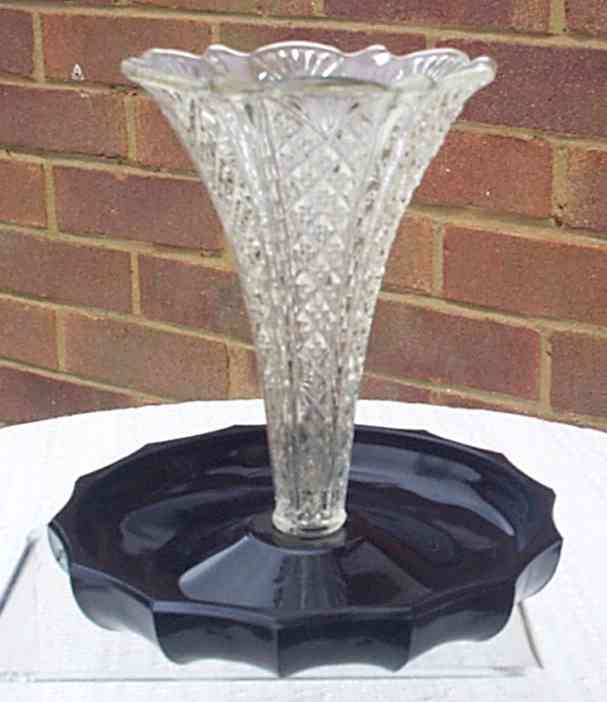 New life was also given to the 269
pattern (Reg
Design No 533040). Nine and ten inch plates in this pattern were sold with
chrome handles as one- or two-tier cake plates, an idea Davidson were to use again in
1958. The Good Companion and Globe Lamps were also still being sold, and using
the same pre-war picture in the advert! They were available in Flint, Amber,
Emerald, Blue and Amber Cloud.
New life was also given to the 269
pattern (Reg
Design No 533040). Nine and ten inch plates in this pattern were sold with
chrome handles as one- or two-tier cake plates, an idea Davidson were to use again in
1958. The Good Companion and Globe Lamps were also still being sold, and using
the same pre-war picture in the advert! They were available in Flint, Amber,
Emerald, Blue and Amber Cloud.
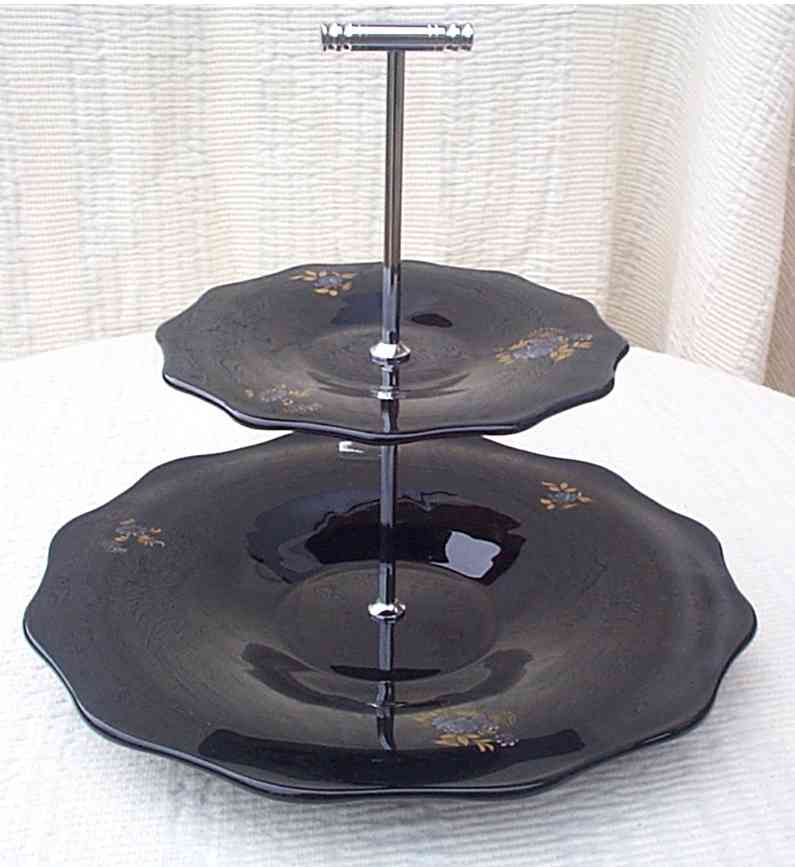 The following year was again to see many more designs. Another pattern, the 504, was made in the form of one and two tier cake stands using the same chrome handles.
A new vase was introduced. The 8" 510, which appears to be a modified form of the No 51 vase
with a impressed diamond pattern. Another posy set which used the 1898 pattern
on the flower holder was also introduced. The 508, as it was called, had a large
black bowl with a dimpled interior. This was also marketed as a
fruit bowl and was shown as such in a 1958 advert.
The following year was again to see many more designs. Another pattern, the 504, was made in the form of one and two tier cake stands using the same chrome handles.
A new vase was introduced. The 8" 510, which appears to be a modified form of the No 51 vase
with a impressed diamond pattern. Another posy set which used the 1898 pattern
on the flower holder was also introduced. The 508, as it was called, had a large
black bowl with a dimpled interior. This was also marketed as a
fruit bowl and was shown as such in a 1958 advert.
 A new posy bowl, the 514 was the subject of one of the adverts in the Pottery Gazette that year. The posy set, somewhat similar to the Sowerby one often seen in Purple Cloud Glass, came in a range of pastel colours with a matt white flower dome. It also came in two sizes, 61/2 and 9" in diameter.
The design of this posy set was very modern and showed how old shapes could be
transformed into very contemporary designs.
A new posy bowl, the 514 was the subject of one of the adverts in the Pottery Gazette that year. The posy set, somewhat similar to the Sowerby one often seen in Purple Cloud Glass, came in a range of pastel colours with a matt white flower dome. It also came in two sizes, 61/2 and 9" in diameter.
The design of this posy set was very modern and showed how old shapes could be
transformed into very contemporary designs.
Lead crystal glassware was a new departure for Davidson and in Mid 1958 they introduced "Baronet Crystal", their first offering being a No 600 covered preserve.
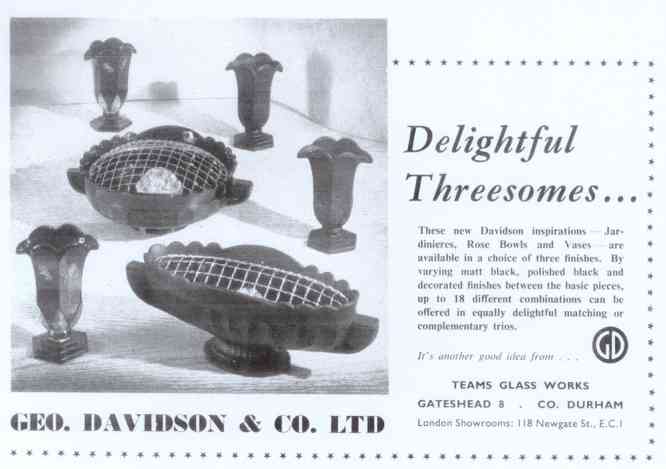 The range of decorated black glassware was also extended with the introduction of the 518 oval and 519 round flower bowls. These were
based on the 1937 Grecian ware. Both came with an optional metal wire flower holder. A new black vase,
the No 517, was introduced as well. The vase had embossed gilt leaf decoration at the base and with optional floral transfers.
The range of decorated black glassware was also extended with the introduction of the 518 oval and 519 round flower bowls. These were
based on the 1937 Grecian ware. Both came with an optional metal wire flower holder. A new black vase,
the No 517, was introduced as well. The vase had embossed gilt leaf decoration at the base and with optional floral transfers.
Trinket sets still were a popular line, and an advert for 5516 set appeared in the Pottery Gazette. The trinket set came in rose, emerald and blue.
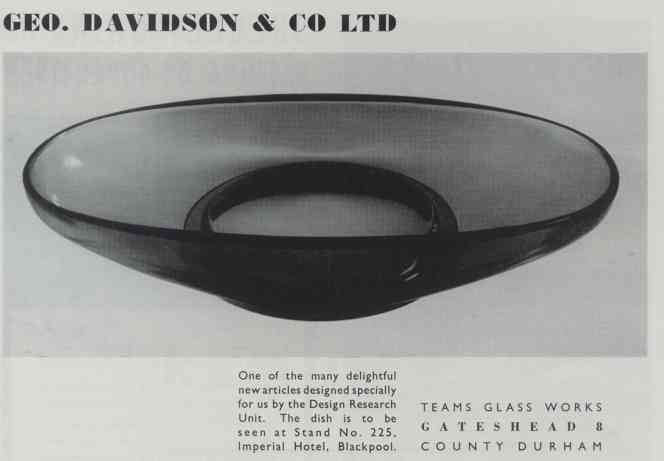 Under new management, the 1960s saw Davidson attempting to produce more contemporary styles in glassware. A hand blown fish
and sets of Fish Floats were introduced in 1960, both of which were made at
Nazeing Glass and sold as Davidson products. A range of Lead Crystal Intaglio
cut glassware also appeared in the same year. The glassware included tots,
tumblers and champagne glasses. The Intaglio decoration was extend to include
other Davidson designs such as the 644 celery and 283 and 1911 dishes. Seeking new ideas, Davidson turned to the Design Centre in London and in 1961 an occasional dish was launched which had been designed by J D Cochrane of the Design Centre and proudly bore the C.o.I.D.
Design Centre label. Described as an oval occasional dish, the 531 dish was 12
inches long by 67/8 inches wide and was available in smoke and
Alabaster colours. This design was subsequently copied by other manufacturers, most noticeably Sowerby, who produced similar shaped designs in a variety of sizes.
Under new management, the 1960s saw Davidson attempting to produce more contemporary styles in glassware. A hand blown fish
and sets of Fish Floats were introduced in 1960, both of which were made at
Nazeing Glass and sold as Davidson products. A range of Lead Crystal Intaglio
cut glassware also appeared in the same year. The glassware included tots,
tumblers and champagne glasses. The Intaglio decoration was extend to include
other Davidson designs such as the 644 celery and 283 and 1911 dishes. Seeking new ideas, Davidson turned to the Design Centre in London and in 1961 an occasional dish was launched which had been designed by J D Cochrane of the Design Centre and proudly bore the C.o.I.D.
Design Centre label. Described as an oval occasional dish, the 531 dish was 12
inches long by 67/8 inches wide and was available in smoke and
Alabaster colours. This design was subsequently copied by other manufacturers, most noticeably Sowerby, who produced similar shaped designs in a variety of sizes.


Old lines were still popular with the consumer. A catalogue from 1961 lists some of the old favourites including the 295 Chevron vase, 296 fan vase, 304 posy, 21 flower bowl and the 732f flower bowl. Many of these were available in ruby as well as smoke, flint, blue, amber and green. Briar is not mentioned in the catalogue so we can assume that it was no longer being made. Some of the Chippendale range was still in production. The catalogue also shows a vase, the 314, and states this was available in alabaster colours.
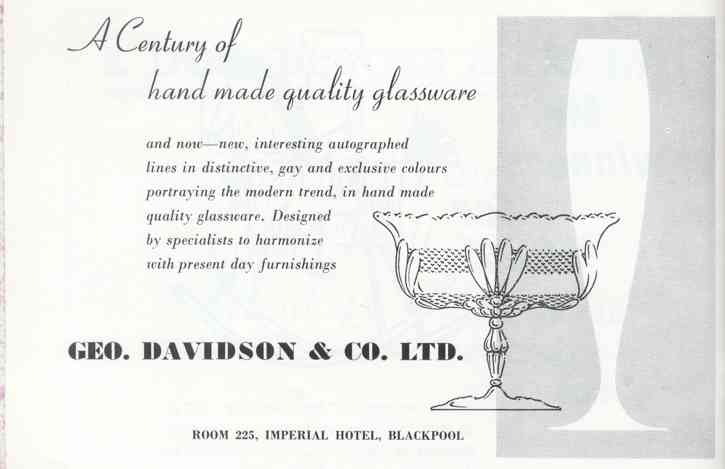 An
advert in the 1962 Pottery Gazette has the leader 'A Century of hand-made
Glassware'. This was a slight exaggeration as the glassworks was founded in
1867. A feature of their 1961 and 1962 displays at the Blackpool Fair was an
exhibition of historical pieces. The 1962 display was augmented with 'several
recently acquired items'. In subsequent years Davidson did attempt to reintroduce some early Victorian designs.
The advert mentioned above shows a rather old-fashioned looking footed bowl with the words 'Interesting autographed lines in distinctive, gay and exclusive colours portraying the modern trend in hand made quality glassware'. This does not seem to have applied to the bowl illustrated!
An
advert in the 1962 Pottery Gazette has the leader 'A Century of hand-made
Glassware'. This was a slight exaggeration as the glassworks was founded in
1867. A feature of their 1961 and 1962 displays at the Blackpool Fair was an
exhibition of historical pieces. The 1962 display was augmented with 'several
recently acquired items'. In subsequent years Davidson did attempt to reintroduce some early Victorian designs.
The advert mentioned above shows a rather old-fashioned looking footed bowl with the words 'Interesting autographed lines in distinctive, gay and exclusive colours portraying the modern trend in hand made quality glassware'. This does not seem to have applied to the bowl illustrated!
 1964 saw the reintroduction, after
a lapse of about 60 years, of slag glass. White and deep purple coloured glass were mixed together, the result very similar to an opaque cloud glass. Slag glass was very popular in Victorian times and widely made by all of the English manufacturers. This new-old form of glassware, which at the time of the Blackpool Fancy Goods
Fair had no name, received a mixed reception. It was popular with antique dealers, who presumably hoped to sell it as original Victorian glassware! A range of both Victorian and more modern styles were made in slag glass. These included the 296 fan vase, the 697 flower bowl and the 697 candlesticks. By June of 1964 Davidson had decided on a name for this range of slag glass - 'Marble Glassware'. Today it is known as Lava by collectors.
Davidson also introduced a new colour in 1964 - Antique Green. At the time their
most popular colours were ruby and midnight blue.
1964 saw the reintroduction, after
a lapse of about 60 years, of slag glass. White and deep purple coloured glass were mixed together, the result very similar to an opaque cloud glass. Slag glass was very popular in Victorian times and widely made by all of the English manufacturers. This new-old form of glassware, which at the time of the Blackpool Fancy Goods
Fair had no name, received a mixed reception. It was popular with antique dealers, who presumably hoped to sell it as original Victorian glassware! A range of both Victorian and more modern styles were made in slag glass. These included the 296 fan vase, the 697 flower bowl and the 697 candlesticks. By June of 1964 Davidson had decided on a name for this range of slag glass - 'Marble Glassware'. Today it is known as Lava by collectors.
Davidson also introduced a new colour in 1964 - Antique Green. At the time their
most popular colours were ruby and midnight blue.
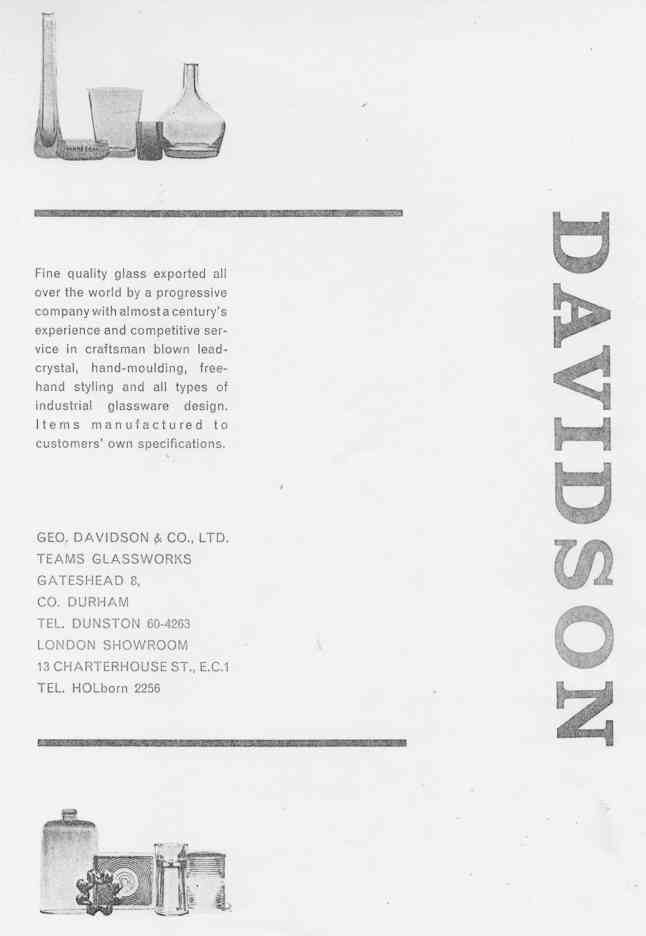 A
range of very contemporary glassware appeared around 1966 as the advert on the right shows.
These reflected the modern taste for contemporary and stylish accessories for
the modern home. These styles are quite difficult to find these days; partly
this is because so many other manufacturers were producing similar designs. It
also very rare to find an example with it's original label and thus help
identification. It is interesting to note that their 1968 catalogue does not
show any of this very modern design. A
range of very contemporary glassware appeared around 1966 as the advert on the right shows.
These reflected the modern taste for contemporary and stylish accessories for
the modern home. These styles are quite difficult to find these days; partly
this is because so many other manufacturers were producing similar designs. It
also very rare to find an example with it's original label and thus help
identification. It is interesting to note that their 1968 catalogue does not
show any of this very modern design.In contrast they introduced a range called Victoriana which consisted of dishes etc in their hobnail pattern, Registered Design No 153858 from 1890. It seems that Davidson were attempting to find a market with both the traditionalist and the modern man or woman.
|
|
|

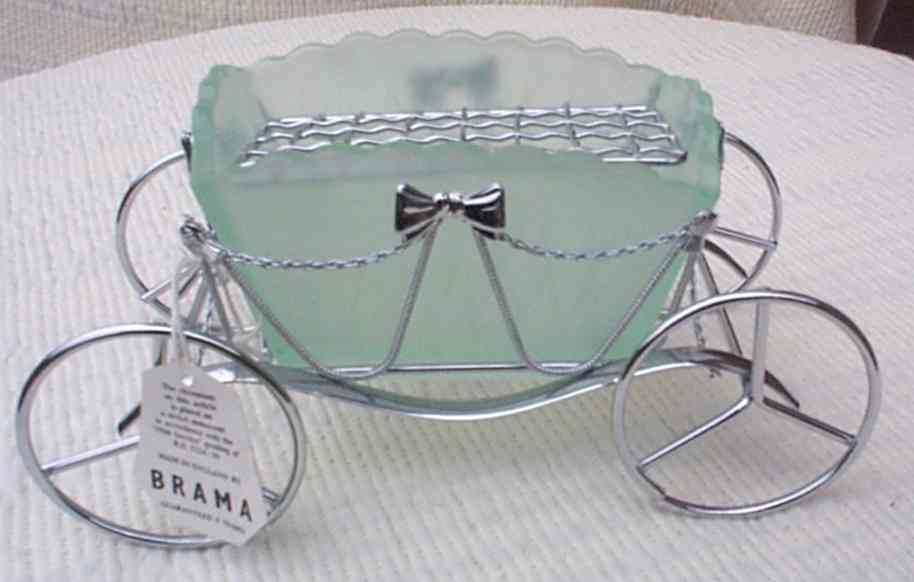
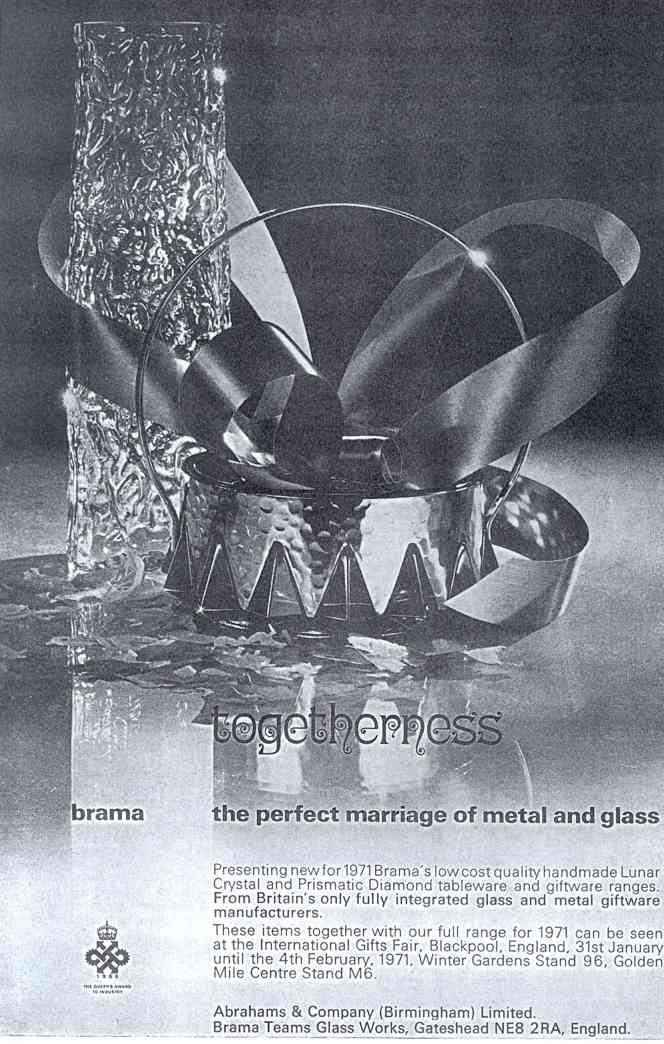 More contemporary glassware was introduced in 1970 and 1971. some of which was designed by G C Merryweather. 1971 saw
the introduction of the 'Luna' range of glassware which had a sculptured surface
which looked like the bark of a tree. Davidson were not the only company
producing glassware with this appearance. Whitefriars are probably the most well know manufacturer of this style of glass. More contemporary glassware was introduced in 1970 and 1971. some of which was designed by G C Merryweather. 1971 saw
the introduction of the 'Luna' range of glassware which had a sculptured surface
which looked like the bark of a tree. Davidson were not the only company
producing glassware with this appearance. Whitefriars are probably the most well know manufacturer of this style of glass.
After 1971 there is very little news about Davidson in the records. In 1977 they are known to have produced a silver jubilee commemorative plate in the style of their Victorian predecessors. After struggling for many years, the glassworks closed in 1987 and the company was dissolved in 1992.
|
This article has concentrated on Davidson's fancy glassware. This was but one aspect of their production. As well as industrial glassware they produced glass for the catering and the domestic market. That is another story....
|
|
|
|
 One of the colours of fancy glassware that appeared in the early to mid 1950s was ruby.
Davidson had made ruby glass before the war, but only for items such as
obstruction and warning lights. A shortage of Selenium immediately after the way
prevented the production of pinks and reds. Ruby was a very popular colour,
particularly in the early years of the 1960s. Davidson also attempted to make
Amberina glass in the 1960s. Amberina is glass which shades from amber to ruby
and results from reheating a small part of the glass. Only a few examples are
known, these include a round 269 dish and a 283 8" flower bowl. These are both
'reverse Amberina' - red at the bottom and amber at the top.
One of the colours of fancy glassware that appeared in the early to mid 1950s was ruby.
Davidson had made ruby glass before the war, but only for items such as
obstruction and warning lights. A shortage of Selenium immediately after the way
prevented the production of pinks and reds. Ruby was a very popular colour,
particularly in the early years of the 1960s. Davidson also attempted to make
Amberina glass in the 1960s. Amberina is glass which shades from amber to ruby
and results from reheating a small part of the glass. Only a few examples are
known, these include a round 269 dish and a 283 8" flower bowl. These are both
'reverse Amberina' - red at the bottom and amber at the top.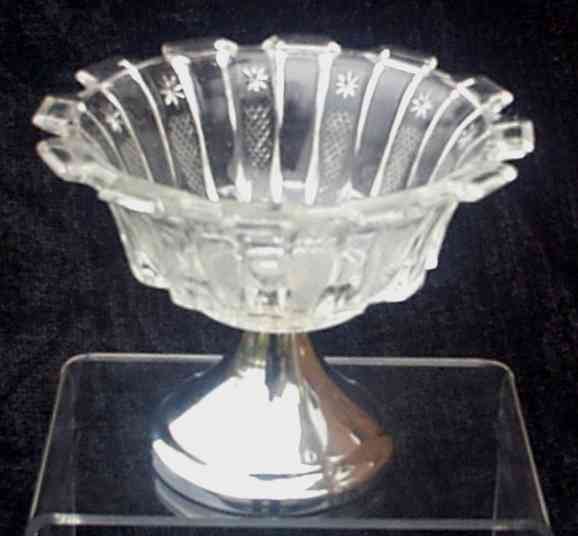 Davidson's
merger with Brama
in 1966
had also increased the range of glassware sold with chrome fittings. In 1967 Brama
Davidson had a fully integrated glass and metal production facility, the
only one in Europe.
Davidson's
merger with Brama
in 1966
had also increased the range of glassware sold with chrome fittings. In 1967 Brama
Davidson had a fully integrated glass and metal production facility, the
only one in Europe. 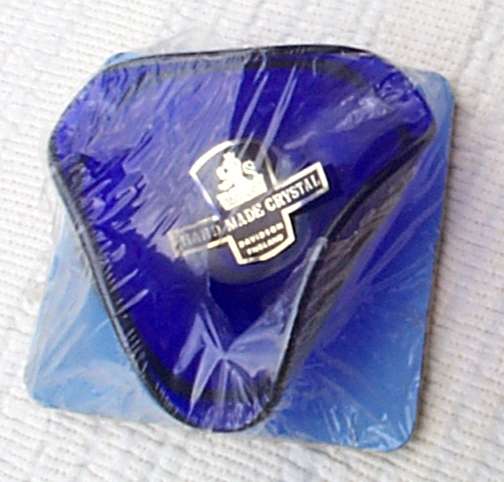 Davidson were conscious of presenting a modern
image and in 1968 they proudly announced the introduction of 'shrink
wrapped' glassware. Individual items were shrink wrapped over a piece of
card. Large sets were shrink-wrapped in boxes. Even as late as 1968, some of
Davidson's old lines were still in production. These included the 1896 and
1912 ranges and the 204 posy.
Davidson were conscious of presenting a modern
image and in 1968 they proudly announced the introduction of 'shrink
wrapped' glassware. Individual items were shrink wrapped over a piece of
card. Large sets were shrink-wrapped in boxes. Even as late as 1968, some of
Davidson's old lines were still in production. These included the 1896 and
1912 ranges and the 204 posy.